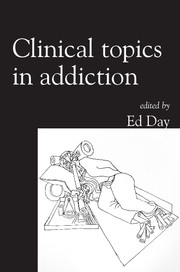Book contents
- Frontmatter
- Contents
- List of tables
- List of boxes
- List of figures
- List of contributors
- Foreword by Nat Wright
- Preface
- 1 What works in drug addiction?
- 2 The development of the drug treatment system in England
- 3 Stimulant use still going strong
- 4 Adverse effects of khat: a review
- 5 What the clinician needs to know about magic mushrooms
- 6 What works in alcohol use disorders?
- 7 Management of alcohol detoxification
- 8 Nicotine addiction and smoking cessation treatments
- 9 Pathological gambling: an overview of assessment and treatment
- 10 Use of investigations in the diagnosis and management of alcohol use disorders
- 11 Laboratory investigations for assessment and management of drug problems
- 12 Pharmacotherapy in dual diagnosis
- 13 Dual diagnosis: management within a psychosocial context
- 14 Treating depression complicated by substance misuse
- 15 Treating anxiety complicated by substance misuse
- 16 An overview of psychological interventions for addictive behaviours
- 17 Motivational interviewing
- 18 Substance misuse in adolescents
- 19 Management of drug misuse in pregnancy
- 20 Intoxication and legal defences
- 21 Substance misuse and violence: the scope and limitations of forensic psychiatry's role
- 22 Literary and biographical perspectives on substance use
- Index
18 - Substance misuse in adolescents
Published online by Cambridge University Press: 02 January 2018
- Frontmatter
- Contents
- List of tables
- List of boxes
- List of figures
- List of contributors
- Foreword by Nat Wright
- Preface
- 1 What works in drug addiction?
- 2 The development of the drug treatment system in England
- 3 Stimulant use still going strong
- 4 Adverse effects of khat: a review
- 5 What the clinician needs to know about magic mushrooms
- 6 What works in alcohol use disorders?
- 7 Management of alcohol detoxification
- 8 Nicotine addiction and smoking cessation treatments
- 9 Pathological gambling: an overview of assessment and treatment
- 10 Use of investigations in the diagnosis and management of alcohol use disorders
- 11 Laboratory investigations for assessment and management of drug problems
- 12 Pharmacotherapy in dual diagnosis
- 13 Dual diagnosis: management within a psychosocial context
- 14 Treating depression complicated by substance misuse
- 15 Treating anxiety complicated by substance misuse
- 16 An overview of psychological interventions for addictive behaviours
- 17 Motivational interviewing
- 18 Substance misuse in adolescents
- 19 Management of drug misuse in pregnancy
- 20 Intoxication and legal defences
- 21 Substance misuse and violence: the scope and limitations of forensic psychiatry's role
- 22 Literary and biographical perspectives on substance use
- Index
Summary
Summary The increasing prevalence of substance misuse among adolescents means that child and adolescent mental health clinicians now have to seriously consider providing specialist assessment and treatment to young people with such disorders. This chapter outlines the differences between adolescent and adult substance misuse and why clinical approaches need to be different. It also proposes an assessment scheme that focuses on a contextual approach to understanding the drivers behind substance use in young people. Finally the possible screening treatment and intervention approaches are outlined. Two appendices provide a short screening instrument and the components of a semi-structured assessment.
There is increasing evidence that substance misuse among British adolescents is escalating (Miller & Plant, 1996; Sutherland & Willner, 1998). In 1992 the prevalence of drug use among adolescents aged 12–17 years referred to mental health services in England was 13.1% (16.3% among boys and 9.3% among girls) (Swadi, 1992). In more recent data from the USA, prevalence of substance use disorders in mental health treatment settings ranged from 19% to 87% (Deas-Nesmith et al, 1998; Aarons et al, 2001).
In the UK there has been historical emphasis on prevention rather than treatment for substance misuse by adolescents. However, there is increasing evidence that universal prevention strategies are relatively ineffective and limited to mild effects on drinking behaviour in adolescence (Spoth et al, 1998), although targeted selective prevention may be more effective (Tobler et al, 2000; Gottfredson & Wilson, 2003; Stewart et al, 2005). There has now been a significant increase in the provision of services for young people with substance misuse issues in the UK involving the development of a number of treatment models (Didlock & Cheshire, 2005).
Why treat adolescents?
Some have viewed substance use in adolescence as a normative behaviour during that period of development, given the fact that alcohol use and experimentation with drugs are so widespread among adolescents (Miller & Plant, 1996; Johnston et al, 1998). With that in mind, a potential point of contention is whether or not we should concern ourselves with treatment.
- Type
- Chapter
- Information
- Clinical Topics in Addiction , pp. 240 - 258Publisher: Royal College of PsychiatristsPrint publication year: 2007



